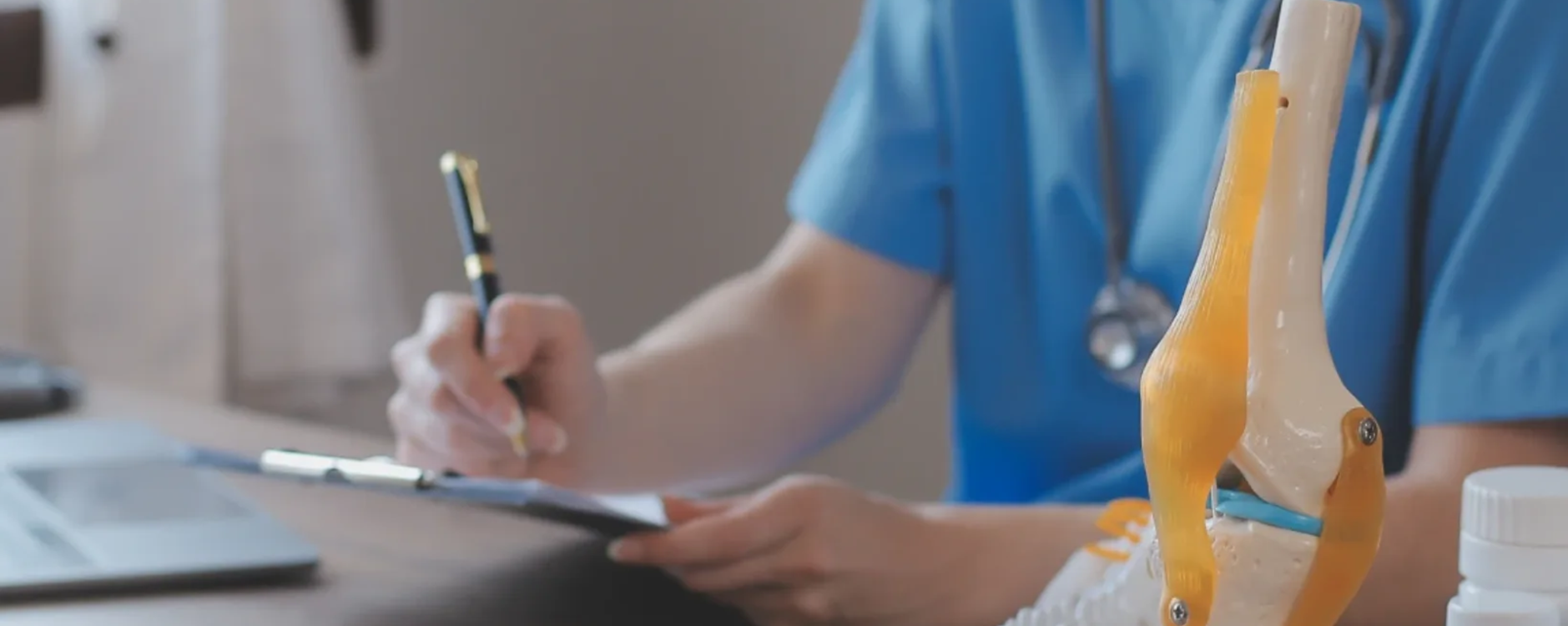Key Takeaways
- Orthopedic medical billing requires precise use of CPT and ICD-10 codes based on procedure type, anatomical site, and injury status (e.g., initial vs. subsequent encounter).
- Modifiers like 59, 78, and 50 are essential for proper reimbursement and must be supported by clear documentation.
- Frequent errors include missing 7th characters, unspecified diagnoses, and incorrect procedure coding (open vs. arthroscopic).
- Denials can be reduced by verifying eligibility, pre-authorizing surgeries, auditing documentation, and using front-end claim scrubbers.
- Compliance depends on linking diagnosis to procedure, respecting global periods, and adhering to payer-specific rules.
When the CPT code for a total knee replacement (27447) is entered incorrectly, or a modifier like 59 or 78 is used the wrong way during an orthopedic consultation, the impact goes beyond a slow payment. It can lead to claim denials, audits, compliance issues, and significant revenue loss.
Orthopedic billing is complex. It often involves global surgical packages, procedures on more than one body part, and strict links between procedure codes (CPT) and diagnosis codes (ICD-10-CM). Mistakes in coding or documentation can quickly become costly.
Orthopedic medical billing services aren’t just about getting paid. It’s also about keeping your practice financially stable and compliant with payer and regulatory rules. However, in-house billing teams face constant challenges, including frequent code updates, complex modifier rules, and changing payer policies.
This guide simplifies the complex process of orthopedics medical billing. It provides clear steps, smart strategies, and real-world tools to help your team code accurately, lower denial rates, and improve cash flow.

Table of Contents
Toggle- Orthopedic Coding Cheat Sheet 2025: Understanding Orthopedic Procedures
- Anatomical Terminology Relevant to Coding
- Orthopedic CPT Codes
- Code Selection Guidelines
- ICD-10 Codes and Their Application
- Tips for Accurate Diagnosis Coding
- Modifiers and Their Correct Usage
- Key Scenario Applications
- Compliance and Documentation
- Revenue Optimization Strategies
- Common Pitfalls and How to Avoid Them
- Conclusion
- Frequently Asked Questions (FAQs)
Orthopedic Coding Cheat Sheet 2025: Understanding Orthopedic Procedures
Orthopedic billing starts with a clear understanding of the procedures being performed. Incorrect procedure identification leads directly to inaccurate code assignment. Coders must be fluent in CPT and ICD-10 codes, as well as the clinical context behind each service.
Common Orthopedic Surgeries and Treatments
Orthopedic practices frequently handle a wide range of high-value procedures, many of which have multiple coding layers depending on approach, hardware used, or laterality. Some of the most commonly billed procedures include:
- Total Joint Replacements:
- Total Knee Arthroplasty (TKA) – CPT 27447
- Total Hip Arthroplasty (THA) – CPT 27130
These procedures often require coding for preoperative imaging, physical therapy, and postoperative follow-up as part of the overall surgical package.
- Total Knee Arthroplasty (TKA) – CPT 27447
- Fracture Repair and Fixation:
- Open Treatment of Distal Radius Fracture – CPT 25607 to 25609 (depending on complexity)
- Be cautious when coding external fixation devices, as they may require separate codes (e.g., 20690 for applying a uniplanar external fixator).
- Open Treatment of Distal Radius Fracture – CPT 25607 to 25609 (depending on complexity)
- Spine Procedures:
- Laminectomy for spinal stenosis – CPT 63030
- Spinal fusion with instrumentation – CPT range 22630–22840
Coding spine surgeries often demands detailed documentation about vertebral levels and whether the approach is anterior, posterior, or combined.
- Laminectomy for spinal stenosis – CPT 63030
- Arthroscopic Procedures:
- Shoulder arthroscopy with rotator cuff repair – CPT 29827
- Knee arthroscopy with meniscectomy – CPT 29881
These minimally invasive procedures often include bundled services, and coders must avoid unbundling errors.
- Shoulder arthroscopy with rotator cuff repair – CPT 29827
- Tendon and Ligament Repairs:
- Anterior Cruciate Ligament (ACL) Reconstruction – CPT 29888
- Achilles Tendon Repair – CPT 27650
Correct coding depends on whether the repair is primary or revision and whether grafts were used.
Anatomical Terminology Relevant to Coding
Precise anatomical knowledge is essential for distinguishing between procedures and applying the correct codes. Understanding the procedures from a clinical and coding perspective is what separates average orthopedic billing from exceptional billing. Coders who stay up to date on anatomical context and surgical nuances reduce denials and improve claim accuracy.
For example:
- Laterality Matters: Coders must differentiate between procedures performed on the right or left side (e.g., right knee meniscectomy vs. left knee meniscectomy). ICD-10 codes often include laterality (e.g., M17.11—Unilateral primary osteoarthritis of the right knee).
- Joint Specificity: Terms like “glenohumeral joint” (shoulder), “femoroacetabular joint” (hip), or “tibiotalar joint” (ankle) frequently appear in operative notes. Accurate interpretation of these terms prevents miscoding.
- Tissue Involvement: Know the difference between terms such as “bursa,” “tendon,” “ligament,” and “meniscus.” For instance, CPT 27370 is for aspirating a bursa, not a joint.
- Surgical Approach and Depth: Whether a procedure is performed open, percutaneously, or arthroscopically changes the code. For example, a rotator cuff repair via open surgery (CPT 23410) differs from arthroscopic repair (CPT 29827).

Orthopedic CPT Codes
Use Specific CPT Codes for Orthopedic Procedures
- Joint Replacements
- 27447 – Total knee arthroplasty (TKA)
- 27130 – Total hip arthroplasty (THA)
- 23472 – Total shoulder arthroplasty
- 27447 – Total knee arthroplasty (TKA)
- Fracture Treatment
- 25607 – Open treatment of distal radial extra-articular fracture
- 26615 – Open treatment of metacarpal fracture with internal fixation
- 27758 – Open treatment of bimalleolar ankle fracture
- 25607 – Open treatment of distal radial extra-articular fracture
- Arthroscopy
- 29881 – Knee arthroscopy with meniscectomy (medial or lateral)
- 29827 – Shoulder arthroscopy with rotator cuff repair
- 29888 – Knee arthroscopy with ACL reconstruction
- 29881 – Knee arthroscopy with meniscectomy (medial or lateral)
- Spinal Procedures
- 63030 – Laminectomy, lumbar, single level
- 22630 – Lumbar interbody fusion, single level
- 22842 – Spinal instrumentation, segmental, 2–3 vertebral segments
- 63030 – Laminectomy, lumbar, single level
- Tendon and Ligament Repair
- 27650 – Achilles tendon repair
- 23410 – Open rotator cuff repair, acute
- 23412 – Open rotator cuff repair, chronic
- 27650 – Achilles tendon repair
- Injections and Aspiration
- 20610 – Aspiration/injection of major joint (e.g., knee, shoulder)
- 20605 – Aspiration/injection of intermediate joint (e.g., elbow, wrist)
- 20610 – Aspiration/injection of major joint (e.g., knee, shoulder)
Code Selection Guidelines
- Procedure Description Must Match Operative Note: Do not rely solely on the surgeon’s listed orthopedic surgery CPT codes; confirm procedure details (e.g., open vs. arthroscopic).
- Include Laterality and Number of Sites: Use modifiers -RT/-LT when applicable. Bilateral procedures may require modifier -50.
- Use Modifier 22 for Increased Procedural Services: Only when documentation supports significantly greater complexity than usual.
- Avoid Unbundling: Example: 29880 includes both medial and lateral meniscectomy; don’t report 29881 twice.
- Global Period Implications: Know when to apply modifier -58 (staged), -78 (related, unplanned), or -79 (unrelated) for procedures within the global surgical period.
- Implants and Devices: Report separately using HCPCS Level II codes (e.g., C1776 – Joint device, implantable).
- Be Specific on Anatomical Levels: For spine codes, note the exact vertebrae involved to avoid upcoding or undercoding.
ICD-10 Codes and Their Application
Common ICD-10 Codes in Orthopedic Diagnoses
- Osteoarthritis
- M17.11 – Unilateral primary osteoarthritis, right knee
- M16.12 – Unilateral primary osteoarthritis, left hip
- M19.011 – Primary osteoarthritis, right shoulder
- M17.11 – Unilateral primary osteoarthritis, right knee
- Fractures
- S52.501A – Unspecified fracture of right radius, initial encounter
- S82.202A – Unspecified fracture of left tibia, initial encounter
- S42.001A – Unspecified fracture of clavicle, right side, initial encounter
- S52.501A – Unspecified fracture of right radius, initial encounter
- Tendon/Ligament Injuries
- S83.511A – Sprain of anterior cruciate ligament (ACL), right knee
- S86.011A – Strain of Achilles tendon, right leg
- S43.421A – Sprain of rotator cuff, right shoulder
- S83.511A – Sprain of anterior cruciate ligament (ACL), right knee
- Spinal Conditions
- M48.061 – Spinal stenosis, lumbar region with neurogenic claudication
- M51.26 – Other intervertebral disc displacement, lumbar region
- M54.5 – Low back pain
- M48.061 – Spinal stenosis, lumbar region with neurogenic claudication
- Postoperative Complications
- T84.84XA – Pain due to orthopedic prosthetic device, initial encounter
- T81.40XA – Infection following a procedure, unspecified, initial encounter
- T84.84XA – Pain due to orthopedic prosthetic device, initial encounter
Tips for Accurate Diagnosis Coding
- Use the 7th Character for Injuries: “A” for initial encounter, “D” for subsequent, “S” for sequela. Always required for fracture and injury codes.
- Code to the Highest Specificity: Never truncate codes. For example, use M17.11 instead of M17.1.
- Link Diagnoses to Procedure: Ensure the ICD-10 code supports medical necessity for the CPT code reported.
- Sequence Appropriately: Primary diagnosis = reason for visit—secondary diagnoses = comorbidities or related conditions.
- Avoid Overuse of “Unspecified”: Only use when no further clinical information is available. Frequent use may flag claims for audit or denial.
Modifiers and Their Correct Usage
Common Orthopedic Modifiers
- Modifier 59 – Distinct procedural service used when two procedures commonly bundled are performed on different anatomical sites or during separate sessions.
Example: 29881 (medial meniscectomy) + 29875 (synovectomy, different compartment) → Append modifier 59 to 29875.
- Modifier 76 – Repeat procedure by same provider
Example: A post-op X-ray repeated by the same orthopedic surgeon on the same day because of patient movement.
- Modifier 77 – Repeat procedure by a different provider
Example: The second provider repeats post-reduction imaging for confirmation.
- Modifier 78 – Unplanned return to OR during global period (related procedure)
Example: Wound dehiscence after knee arthroplasty requires irrigation and debridement within a 90-day global period.
- Modifier 79 – Unrelated procedure during global period
Example: A patient undergoes rotator cuff repair on the shoulder and then has an unrelated ankle fracture repair within 90 days.
- Modifier 58 – Staged or planned procedure during global period
Example: Hardware removal was planned after open reduction internal fixation (ORIF), which was part of the original treatment plan.
- Modifier 50 – Bilateral procedure
Example: Bilateral knee arthroscopy (29881) performed on the same day.
- Modifier LT/RT – Left/Right side
Example: Injection of left knee – use 20610 with modifier LT.
- Modifier XE – Separate encounter
Use when procedures of the same code are done at different times during the same day.
Example: 20610 was performed in the morning and repeated later due to joint effusion.
- Modifier XP – Separate practitioner
Use when a different provider performs a similar service during the same visit.
Example: Joint aspiration by a different orthopedic provider during the same encounter.
- Modifier XP – Separate practitioner
- Use when a different provider performs a similar service during the same visit.
- Example: Joint aspiration by a different orthopedic provider during the same encounter.
Key Scenario Applications
-
29827 + 29824 (Arthroscopic rotator cuff repair + distal clavicle excision)
Use modifier 59 on 29824 to indicate a separate anatomical site. -
20610 x2 (Joint injection, performed twice, different joints)
Use modifier 59 or XE on the second 20610 to indicate distinct service. -
Laminectomy at L3-L4 and spinal fusion at L5-S1
Modifier 59 is required if CPT codes are bundled by NCCI edits but performed at non-overlapping sites. -
Post-op debridement within 10 days of TKA (27447)
Use modifier 78 to report unplanned return to the OR for wound complications.

Compliance and Documentation
Best Practices for Maintaining Compliance
- Adhere to NCCI Edits
Always check the National Correct Coding Initiative (NCCI) for procedure bundling rules before submitting claims.
- Apply Correct Modifiers with Justification
Clear documentation must support the use of modifiers (e.g., anatomical site, separate session, and different provider).
- Audit Internal Claims Regularly
Conduct monthly coding audits to detect overcoding, undercoding, and modifier misuse.
- Follow Global Surgery Guidelines
Avoid billing separately for services included in the global package, such as routine post-op visits.
- Stay Updated on Payer-Specific Rules
Medicare and private insurers may differ in their recognition of modifiers and bundling policies.
- Avoid Upcoding
Code only for services performed and documented. Do not bill higher-level E/M or complex procedures without clear justification.
- Implement Signed and Dated Documentation
All clinical notes must be signed and dated by the performing provider—missing signatures are audit triggers.
Documentation Requirements to Support Coding
- Procedure Note Must Match CPT Code
Include procedure name, technique, laterality, approach (open/arthroscopic), hardware used, and anatomical location.
- Diagnosis Must Be Specific and Linked to Procedure
Use the most specific ICD-10 code; document clearly how it supports medical necessity.
- Include Laterality in Operative Reports
State “right,” “left,” or “bilateral” explicitly. Coders cannot infer laterality.
- Include Time and Complexity for E/M Coding
For time-based visits, document the total time spent and the complexity of medical decision-making.
- Support Use of Modifiers in Narrative
Example: For modifier 59, document “procedure performed on separate compartment.”
- Global Period Services Must Be Clearly Defined
For staged or related procedures, documentation should include whether the procedure was planned (modifier 58) or unplanned (modifier 78).
- Pre- and Post-Operative Notes
Include pre-op diagnosis, post-op findings, procedure performed, and outcome. Required for all surgical claims.
Partnering with an experienced billing company like Transcure can ease the burden of documentation and compliance. Our orthopedic billing experts ensure that all claims are accurately coded, well-supported, and aligned with payer policies, which reduces audit risk and improves reimbursement timelines.
Revenue Optimization Strategies
Techniques to Reduce Claim Denials
- Verify Insurance Eligibility Before Each Visit
Confirm active coverage, deductible status, authorization requirements, and plan-specific orthopedic exclusions.
- Pre-Authorize High-Cost Procedures
Obtain prior authorization for joint replacements, spine surgeries, and DME (e.g., braces, orthotics). Denials often result from missing or expired authorizations.
- Use ICD-10 and CPT Pairing Tools
Cross-reference diagnosis and procedure codes to ensure medical necessity alignment (e.g., CPT 27447 requires M17.11 or similar OA code).
- Correct Modifier Use
Improper or missing modifiers (59, 78, 79) are a top reason for denials. Always validate modifier requirements with payer-specific guidelines.
- Appeal Denials Within Timely Filing Limits
Use structured appeal templates and submit them within 30–60 days, depending on the payer’s rules.
- Track Denial Reasons by Category
Categorize denials by cause (e.g., coding, authorization, eligibility) to identify recurring issues and adjust workflows accordingly.
Implementing Efficient Billing Workflows
- Use Front-End Edits in EHR/Billing Software
Automate checks for missing modifiers, invalid code pairs, and expired authorizations before claim submission.
- Create CPT/ICD Cheat Sheets for Common Ortho Procedures
Distribute validated code sets per provider to reduce coding errors and increase speed.
- Implement Charge Capture Audits Weekly
Reconcile operative reports against billed procedures to catch omissions, especially for assistant surgeon or implant charges.
- Real-Time Claim Scrubbing
Use clearinghouse tools to identify billing issues, such as missing NPIs and invalid POS codes, before submitting them to the payer.
- Designate a Denials Management Team
Assign staff to monitor, appeal, and report on denials. Include a root-cause feedback loop for the coding and front desk teams.
- Train Coders on Payer-Specific Orthopedic Rules
Example: UnitedHealthcare may bundle codes that Medicare allows to be billed separately. Update coders monthly on policy shifts.
- Implement a 48-Hour Submission Policy
Submit claims within 48 hours after the encounter to accelerate the revenue cycle and flag errors earlier.
Many orthopedic practices work with billing partners like Transcure to streamline their workflows, monitor key performance indicators (KPIs), and reduce denials. Our team helps implement pre-authorization protocols, clean claim submission processes, and denial management systems tailored to orthopedic specialties.

Common Pitfalls and How to Avoid Them
Frequent Errors in Orthopedic Billing and Coding
- Incorrect Use of CPT Codes for Open vs. Arthroscopic Procedures
Example: Billing 23412 (open rotator cuff repair) instead of 29827 (arthroscopic).
Impact: Overpayment risk or denial due to a mismatched operative report.
- Omission of Modifiers on Bilateral or Multiple Site Procedures
Example: Failing to add modifier 50 or 59 for bilateral or separate compartment knee procedures.
Impact: Partial reimbursement or bundled denial.
- Inaccurate Fracture Coding (Open vs. Closed, Displaced vs. Nondisplaced)
Example: Using S82.202A (unspecified tibia fracture) when documentation supports a displaced fracture.
Impact: Underpayment or clinical mismatch during audit.
- Billing Post-Op Services Without Modifiers During Global Period
Example: Reporting debridement without modifier 78 within the 90-day TKA global period.
Impact: Denied as bundled into the global fee.
- Unspecified Diagnosis Codes (e.g., M17.9)
Impact: Increases audit risk; payers may deny due to a lack of specificity.
- Unlinked Diagnoses and Procedures
Example: Reporting CPT 27447 with M54.5 (low back pain).
Impact: Denial due to lack of medical necessity.
Preventative Measures and Corrective Actions
- Audit Operative Reports Against Billed Codes Weekly
Confirm correct procedure code, laterality, and approach (open vs. arthroscopic).
- Require Modifiers Checklist Before Claim Submission
Implement pre-submission checklist for modifiers 59, 78, 79, 50, RT/LT.
- Train Staff on 7th Character Use for Injury Diagnoses
Use EHR prompts to enforce the correct use of “A” (initial), “D” (subsequent), and “S” (sequela).
- Use Specific ICD-10 Cheat Sheets per Body Region
Replace M17.9 with M17.11 or M17.12. Eliminate the use of unspecified codes.
- Implement Denial Reason Reporting Dashboard
Track denial frequency by error type to prioritize training and process fixes.
- Enable Front-End Scrubbing for Code Validation
Ensure that the EHR or clearinghouse flags missing characters, invalid code combinations, and modifier errors before submission.
- Create an Internal Review Protocol for Global Period Services
Require documentation review and coding sign-off for any billable post-op service during the 10- or 90-day global window.
Conclusion
Orthopedic medical billing demands precision, up-to-date coding knowledge, and a deep understanding of surgical procedures and documentation standards. From managing global periods to applying modifiers accurately, every detail contributes to ensuring clean claims and optimal reimbursement. By adopting specialized orthopedic billing strategies and working with experienced billing partners, practices can reduce denials, stay compliant, and maintain a healthy revenue cycle without compromising patient care.
Frequently Asked Questions (FAQs)
What is orthopedic medical billing, and how is it different from general medical billing?
Orthopedic medical billing focuses specifically on the coding and billing of services related to bones, joints, muscles, and connective tissues. It involves a deeper understanding of musculoskeletal procedures, anatomy-specific codes, and complex surgical bundling rules, which differ from those in general medical billing.
What are the most commonly used CPT codes in orthopedic billing?
Some frequently used CPT codes in orthopedics include:
- 27130 – Total hip replacement
- 27447 – Total knee arthroplasty
- 23410 – Repair of rotator cuff
- 20610 – Joint aspiration or injection
These codes vary depending on the procedures performed and must be supported by accurate documentation.
Why are modifier codes important in orthopedic billing?
Modifiers provide additional information about a procedure, such as whether it was bilateral, staged, or performed by multiple providers. In orthopedics, incorrect or missing modifiers, such as modifier 59, RT/LT, or modifier 22, can lead to underpayment or claim denials.
How can orthopedic practices reduce claim denials and improve reimbursement?
To reduce denials, practices should:
- Ensure accurate ICD-10 and CPT coding
- Use appropriate modifiers
- Maintain detailed documentation
- Conduct regular coding audits
- Partner with specialized orthopedic billing experts
Do orthopedic practices need specialized billing partners?
Yes. Orthopedic billing involves intricate coding, pre-authorization nuances, and payer-specific guidelines. A billing partner with orthopedic expertise can significantly boost claim approval rates and revenue by avoiding common pitfalls, such as unbundling or undercoding.
How often should orthopedic practices conduct coding audits?
Ideally, practices should conduct internal or external audits quarterly to ensure coding accuracy, compliance, and revenue optimization. This helps identify patterns that may lead to denials or underpayments.









